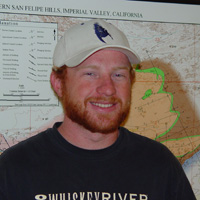 Aaron HebelerElemental Transport and Volume Strain of Fault Core and Damage Zone, San Jacinto Fault Zone, California: Assessing The Influence of Weathering Wednesday, May 9th, 2008 |
||
|
||
| ABSTRACT The Clark segment of the San Jacinto Fault Zone is located in southern California. Our study was aimed at evaluating the chemical and physical properties of fault core and damage zone for the affects of chemical weathering. Fault zones are composed of distinct architectural zones that are based on texture, structural fabric, and grain size. Architectural zones commonly include a fault core, damage zone, and wall rocks. These architectural zones are well displayed in an exposure of the Clark segment of the San Jacinto fault zone. At this location measurements of bulk density progressively decrease from high values in the wall rocks to lower values in the fault core. In contrast, porosity trends show an inverse relation with regard to bulk density trends. In A-CN-K space samples from inner damage zone, outer damage zone, and fault core emanate from a clustering of points derived from the wall rocks toward the A-K join in a systematic progressive fashion. This relationship is consistent with petrological observations that suggest that grain size is systematically reduced within each architectural zone culminating in a generally black structureless aphanitic fault core. In A-CNK-FM space samples again spread in a linear fashion from wall rocks to the fault core toward the A-FM join. This spread again correlates well with each architectural zone and grain size. The transport function, τ, suggests that there is progressive loss of Al, Ca, Na, K, and Sr mass toward the fault core. In contrast, the masses of Fe, Mg, Mn are increased in the fault core relative to the adjacent damage zone and wall rock. The above relations are consistent with the idea that fault zones are greatly susceptible to chemical weathering because of their reduced grain size and hence greater surface area. Moreover, our data suggest that at or near the Earth’s surface they are also highly porous. Apparently chemical weathering under such conditions involves degradation of plagioclase, amphibole, and biotite by migrating soil and paralithic fluids. These fluids remove Al, Ca, Na, K, and Sr from degrading plagioclase, and convert amphiboles and biotites to mixed layer expandable clays such as vermiculite and mixed vermiculite and chlorite. The increase in Fe, Mg, and Mn mass within the fault core implies that the fluids were transporting such ions and that they accumulated within the fault core perhaps by some cation exchange process. |

